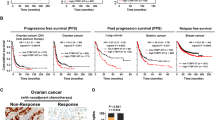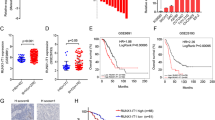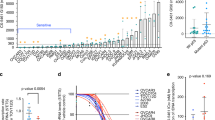Abstract
The transcription factor nuclear factor kappa B (NF-κB) and the long non-coding RNA (lncRNA) HOTAIR (HOX transcript antisense RNA) have diverse functional roles in cancer. In this study, we show that upregulation of HOTAIR induced platinum resistance in ovarian cancer, and increased HOTAIR levels were observed in recurrent platinum-resistant ovarian tumors vs primary ovarian tumors. To investigate the role of HOTAIR during DNA damage induced by platinum, we monitored double-strand breaks and show that HOTAIR expression results in sustained activation of DNA damage response (DDR) after platinum treatment. We demonstrate that ectopic expression of HOTAIR induces NF-κB activation during DDR and interleukin-6 and interleukin-6 expression, both key NF-κB target genes. We show that HOTAIR regulates activation of NF-κB by decreasing Iκ-Bα (NF-κB inhibitor) and establish that by inducing prolonged NF-κB activation and expression of NF-κB target genes during DNA damage, HOTAIR has a critical role in cellular senescence and platinum sensitivity. Our findings suggest that an NF-κB-HOTAIR axis drives a positive-feedback loop cascade during DDR and contributes to cellular senescence and chemotherapy resistance in ovarian and other cancers.
This is a preview of subscription content, access via your institution
Access options
Subscribe to this journal
Receive 50 print issues and online access
$259.00 per year
only $5.18 per issue
Buy this article
- Purchase on Springer Link
- Instant access to full article PDF
Prices may be subject to local taxes which are calculated during checkout







Similar content being viewed by others
References
Zhang X-P, Liu F, Wang W . Regulation of the DNA damage response by p53 cofactors. Biophys J 2012; 102: 2251–2260.
Chien Y, Scuoppo C, Wang X, Fang X, Balgley B, Bolden JE et al. Control of the senescence-associated secretory phenotype by NF-κB promotes senescence and enhances chemosensitivity. Genes Dev 2011; 25: 2125–2136.
Wang J, Jacob NK, Ladner KJ, Beg A, Perko JD, Tanner SM et al. RelA/p65 functions to maintain cellular senescence by regulating genomic stability and DNA repair. EMBO Rep 2009; 10: 1272–1278.
Wu Z-H, Shi Y, Tibbetts RS, Miyamoto S . Molecular linkage between the kinase ATM and NF-κB signaling in response to genotoxic stimuli. Science 2006; 311: 1141–1146.
Janssens S, Tinel A, Lippens S, Tschopp J . PIDD mediates NF-κB activation in response to DNA damage. Cell 2005; 123: 1079–1092.
Deans AJ, West SC . DNA interstrand crosslink repair and cancer. Nat Rev Cancer 2011; 11: 467–480.
Guttman M, Amit I, Garber M, French C, Lin MF, Feldser D et al. Chromatin signature reveals over a thousand highly conserved large non-coding RNAs in mammals. Nature 2009; 458: 223–227.
Wan G, Hu X, Liu Y, Han C, Sood AK, Calin GA et al. A novel non‐coding RNA lncRNA‐JADE connects DNA damage signalling to histone H4 acetylation. EMBO J 2013; 32: p 2833–2847.
Huarte M, Guttman M, Feldser D, Garber M, Koziol MJ, Kenzelmann-Broz D et al. A large intergenic noncoding RNA induced by p53 mediates global gene repression in the p53 response. Cell 2010; 142: p 409–419.
Hung T, Wang Y, Lin MF, Koegel AK, Kotake Y, Grant GD et al. Extensive and coordinated transcription of noncoding RNAs within cell-cycle promoters. Nat Genet 2011; 43: 621–629.
Tsai M-C, Spitale RC, Chang HY . Long intergenic noncoding RNAs: new links in cancer progression. Cancer Res 2011; 71: p 3–7.
Gupta RA, Shah N, Wang KC, Kim J, Horlings HM, Wong DJ et al. Long non-coding RNA HOTAIR reprograms chromatin state to promote cancer metastasis. Nature 2010; 464: 1071–1076.
Guil S, Soler M, Portela A, Carrère J, Fonalleras E, Gómez et al. Intronic RNAs mediate EZH2 regulation of epigenetic targets. Nat Struct Mol Biol 2012; 19: 664–670.
Chu C, Qu K, Zhong FL, Artandi SE, Chang HY . Genomic maps of long noncoding RNA occupancy reveal principles of RNA-chromatin interactions. Mol Cell 2011; 44: 667–678.
Balch C, Huang TH, Brown R, Nephew KP . The epigenetics of ovarian cancer drug resistance and resensitization. Am J Obst Gynecol 2004; 191: 1552–1572.
Liu L, Guo J, Yu L, Cai J, Gui T, Tang H et al. miR-101 regulates expression of EZH2 and contributes to progression of and cisplatin resistance in epithelial ovarian cancer. Tumor Biol 2014; 35: 1–8.
Hu S, Yu L, Li Z, Shen Y, Wang J, Cai J et al. Overexpression of EZH2 contributes to acquired cisplatin resistance in ovarian cancer cells in vitro and in vivo. Cancer Biol Ther 2010; 10: 788–795.
Lee ST, Li Z, Wu Z, Aau M, Guan P, Karuturi RK et al. Context-specific regulation of NF-κB target gene expression by EZH2 in breast cancers. Mol Cell 2011; 43: 798–810.
Yang G, Xiao X, Rosen DG, Cheng X, Wu X, Chang B et al. The biphasic role of NF-κB in progression and chemoresistance of ovarian cancer. Clin Cancer Res 2011; 17: 2181–2194.
Network, C.G.A.R.. Integrated genomic analyses of ovarian carcinoma. Nature 2011; 474: 609–615.
Ciccia A, Elledge SJ . The DNA damage response: making it safe to play with knives. Mol Cell 2010; 40: 179–204.
Zandi E, Rothwarf DM, Delhase M, Hayakawa M, Karin M . The IκB kinase complex (IKK) contains two kinase subunits, IKKα and IKKβ, necessary for IκB phosphorylation and NF-κB activation. Cell 1997; 91: 243–252.
Ozes ON, Mayo LD, Gustin JA, Pfeffer SR, Pfeffer LM, Donner DB . NF-κB activation by tumour necrosis factor requires the Akt serine–threonine kinase. Nature 1999; 401: 82–85.
Canino C, Mori F, Cambria A, Diamantini A, Germoni S, Alessandrini G et al. SASP mediates chemoresistance and tumor-initiating-activity of mesothelioma cells. Oncogene 2011; 31: 3148–3163.
Rodier F, Coppé JP, Patil CK, Hoeijmakers WA, Muñoz DP, Raza SR, Freund et al. Persistent DNA damage signalling triggers senescence-associated inflammatory cytokine secretion. Nat Cell Biol 2009; 11: 973–979.
Gilbert LA, Hemann MT . DNA damage-mediated induction of a chemoresistant niche. Cell 2010; 143: 355–366.
Kuilman T, Michaloglou C, Vredeveld LC, Douma S, van Doorn R, Desmet CJ et al. Oncogene-induced senescence relayed by an interleukin-dependent inflammatory network. Cell 2008; 133: 1019–1031.
Bieging KT, Mello SS, Attardi LD . Unravelling mechanisms of p53-mediated tumour suppression. Nat Rev Cancer 2014; 14: 359–370.
Liu Z, Sun M, Lu K, Liu J, Zhang M, Wu W, De W et al. The long noncoding RNA HOTAIR contributes to cisplatin resistance of human lung adenocarcinoma cells via downregualtion of p21 (WAF1/CIP1) expression. PLoS One 2013; 8: e77293.
Jing L, Yuan W, Ruofan D, Jinjin Y, Haifeng Q . HOTAIR enhanced aggressive biological behaviors and induced radio-resistance via inhibiting p21 in cervical cancer. Tumor Biol 2014; 36: 3611–3619.
Debacq-Chainiaux F, Erusalimsky JD, Campisi J, Toussaint O . Protocols to detect senescence-associated beta-galactosidase (SA-βgal) activity, a biomarker of senescent cells in culture and in vivo. Nat Protoc 2009; 4: 1798–1806.
Malek E, Jagannathan S, Driscoll JJ . Correlation of long non-coding RNA expression with metastasis, drug resistance and clinical outcome in cancer. Oncotarget 2014; 5: 8027.
Wu Z-H, Wang XL, Tang HM, Jiang T, Chen J, Lu S et al. Long non-coding RNA HOTAIR is a powerful predictor of metastasis and poor prognosis and is associated with epithelial-mesenchymal transition in colon cancer. Oncol Rep 2014; 32: 395–402.
Qiu J, Lin YY, Ye LC, Ding JX, Feng WW, Jin HY . Overexpression of long non-coding RNA HOTAIR predicts poor patient prognosis and promotes tumor metastasis in epithelial ovarian cancer. Gynecol Oncol 2014; 134: 121–128.
Vaughan S, Coward JI, Bast RC Jr, Berchuck A, Berek JS, Brenton JD et al. Rethinking ovarian cancer: recommendations for improving outcomes. Nat Rev Cancer 2011; 11: 719–725.
de Visser KE, Eichten A, Coussens LM . Paradoxical roles of the immune system during cancer development. Nat Rev Cancer 2006; 6: 24–37.
Kipps E, Tan DS, Kaye SB . Meeting the challenge of ascites in ovarian cancer: new avenues for therapy and research. Nat Rev Cancer 2013; 13: 273–282.
Almeida LO, Abrahao AC, Rosselli-Murai LK, Giudice FS, Zagni C, Leopoldino AM et al. NFκB mediates cisplatin resistance through histone modifications in head and neck squamous cell carcinoma (HNSCC). FEBS Open Bio 2014; 4: 96–104.
Wang Y, Niu XL, Qu Y, Wu J, Zhu YQ, Sun WJ et al. Autocrine production of interleukin-6 confers cisplatin and paclitaxel resistance in ovarian cancer cells. Cancer Lett 2010; 295: 110–123.
Dijkgraaf EM, Heusinkveld M, Tummers B, Vogelpoel LT, Goedemans R, Jha V et al. Chemotherapy alters monocyte differentiation to favor generation of cancer-supporting M2 macrophages in the tumor microenvironment. Cancer Res 2013; 73: 2480–2492.
Kang C, Xu Q, Martin TD, Li MZ, Demaria M, Aron L et al. The DNA damage response induces inflammation and senescence by inhibiting autophagy of GATA4. Science 2015; 349: aaa5612.
Laberge R-M, Sun Y, Orjalo AV, Patil CK, Freund A, Zhou L et al. MTOR regulates the pro-tumorigenic senescence-associated secretory phenotype by promoting IL1A translation. Nat Cell Biol 2015; 17: 1049–1061.
Heubach J, Monsior J, Deenen R, Niegisch G, Szarvas T, Niedworok C et al. The long noncoding RNA HOTAIR has tissue and cell type-dependent effects on HOX gene expression and phenotype of urothelial cancer cells. Mol Cancer 2015; 14: 108.
Sullivan N, Sasser AK, Axel AE, Vesuna F, Raman V, Ramirez N et al. Interleukin-6 induces an epithelial–mesenchymal transition phenotype in human breast cancer cells. Oncogene 2009; 28: 2940–2947.
Oliver TG, Mercer KL, Sayles LC, Burke JR, Mendus D, Lovejoy KS et al. Chronic cisplatin treatment promotes enhanced damage repair and tumor progression in a mouse model of lung cancer. Genes Dev 2010; 24: 837–852.
Di Micco R, Fumagalli M, Cicalese A, Piccinin S, Gasparini P, Luise C et al. Oncogene-induced senescence is a DNA damage response triggered by DNA hyper-replication. Nature 2006; 444: 638–642.
Yoon J-H, Abdelmohsen K, Kim J, Yang X, Martindale JL, Tominaga-Yamanaka K et al. Scaffold function of long non-coding RNA HOTAIR in protein ubiquitination. Nat Commun 2013; 4: 2939.
Di Minin G, Bellazzo A, Dal Ferro M, Chiaruttini G, Nuzzo S, Bicciato S et al. Mutant p53 reprograms TNF signaling in cancer cells through interaction with the tumor suppressor DAB2IP. Mol Cell 2014; 56: 617–629.
Cooks T, Pateras IS, Tarcic O, Solomon H, Schetter AJ, Wilder S et al. Mutant p53 prolongs NF-κB activation and promotes chronic inflammation and inflammation-associated colorectal cancer. Cancer Cell 2013; 23: 634–646.
Li M, Balch C, Montgomery JS, Jeong M, Chung JH, Yan P et al. Integrated analysis of DNA methylation and gene expression reveals specific signaling pathways associated with platinum resistance in ovarian cancer. BMC Med Genet 2009; 2: 34.
Matei D, Fang F, Shen C, Schilder J, Arnold A, Zeng Y et al. Epigenetic resensitization to platinum in ovarian cancer. Cancer Res 2012; 72: 2197–2205.
Paige JS, Wu KY, Jaffrey SR . RNA mimics of green fluorescent protein. Science 2011; 333: 642–646.
Rao X, Di Leva G, Li M, Fang F, Devlin C, Hartman-Frey C et al. MicroRNA-221/222 confers breast cancer fulvestrant resistance by regulating multiple signaling pathways. Oncogene 2010; 30: 1082–1097.
Wang Y, Cardenas H, Fang F, Condello S, Taverna P, Segar M et al. Epigenetic targeting of ovarian cancer stem cells. Cancer Res 2014; 74: 4922–4936.
Zhang S, Balch C, Chan MW, Lai HC, Matei D, Schilder JM et al. Identification and characterization of ovarian cancer-initiating cells from primary human tumors. Cancer Res 2008; 68: 4311–4320.
Miller DF, Yan PS, Buechlein A, Rodriguez BA, Yilmaz AS, Goel S et al. A new method for stranded whole transcriptome RNA-seq. Methods 2013; 63: 126–134.
Miller DF, Yan PX, Fang F, Buechlein A, Ford JB, Tang H et al. Stranded whole transcriptome RNA‐Seq for all RNA types. Curr Protoc Hum Genet 2015. 11.14. 1–11.14. 23.
Acknowledgements
We thank Aaron Buechlein (Indiana University) for help with bioinformatic analysis of TCGA data, Dr Craig Pikaard (Indian University) for the pAV-spinach vector, Dr Howard Chang (Stanford University) for LZRS-HOTAIR vector, and Dr Heather O’Hagan for carefully reading this manuscript and helpful suggestions. This work was made possible by funding from the National Cancer Institute (Awards CA13001 and CA182832), Walther Cancer Foundation (Indianapolis, IN), and the Doane and Eunice Dahl Wright Fellowship (Medical Sciences Program, Indiana University, Bloomington, IN).
Author information
Authors and Affiliations
Corresponding author
Ethics declarations
Competing interests
The authors declare no conflict of interest.
Additional information
Supplementary Information accompanies this paper on the Oncogene website
Supplementary information
Rights and permissions
About this article
Cite this article
Özeş, A., Miller, D., Özeş, O. et al. NF-κB-HOTAIR axis links DNA damage response, chemoresistance and cellular senescence in ovarian cancer. Oncogene 35, 5350–5361 (2016). https://doi.org/10.1038/onc.2016.75
Received:
Revised:
Accepted:
Published:
Issue Date:
DOI: https://doi.org/10.1038/onc.2016.75
This article is cited by
-
LncRNA EBLN3P attributes methotrexate resistance in osteosarcoma cells through miR-200a-3p/O-GlcNAc transferase pathway
Journal of Orthopaedic Surgery and Research (2022)
-
Neurospora crassa is a potential source of anti-cancer agents against breast cancer
Breast Cancer (2022)
-
Interruption of the long non-coding RNA HOTAIR signaling axis ameliorates chemotherapy-induced cachexia in bladder cancer
Journal of Biomedical Science (2022)
-
Mechanistic study of lncRNA UCA1 promoting growth and cisplatin resistance in lung adenocarcinoma
Cancer Cell International (2021)
-
The long non-coding RNA MIR31HG regulates the senescence associated secretory phenotype
Nature Communications (2021)



